The Praxis of the Procedural Model in Digital Literature, Part 2: Applications
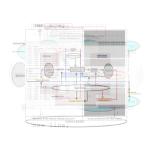
Part 2 of Philippe Bootz's exploration of the procedural mode in digital literature, continued from part 1.
1.1 Points of view from within the model
1.2 How to show different theories from within the model
In order to visualize other theoretical points of view in the procedural model, it is enough to magnify the strokes in the schema and forms considered significant and to grey out the elements neglected in the visualized point of view.
One can also modify the borders of domains in order to show what part of the dispositif each position can manage within this visualization.
Properties of the visualized point of view that cannot be shown on the schema are neglected because it would not be coherent to add new elements to the schema apart from some commentaries. This does not render explicit all features of the visualized point of view, but the modified elements make it easy to compare one point of view to another (Bootz, 2002).
In this chapter I will visualize several well-known theoretical points of view. Each of these visualizations expresses, from within the point of view of the procedural model, the understanding of the dispositif in the visualized theory. It is one part of the profondeur de dispositif of its creator.
1.2 The front-end dispositif
The front-end dispositif (Bootz, 2021) shows the front-end conception which is the most classic conception in the arts. It argues that the work is a text, in the broad sense of a set of signs, whatever these signs are, and that the text the audience addresses has been written by an author. The dispositif then appears as if author and reader would be both in the same space, in front of the text, one writing it, the other reading it.

In this conception, the text the author writes is the same as the text the reader reads. For instance, in printed literature, the text written on the manuscript is the same as the text read in the book. This conception assumes that the work is the text the reader reads, and author and reader are supposed to have the same profondeur de dispositif. Materiality is neglected.

Some conceptions in digital literature shift this point of view, although the front-end point of view often implicitly influences them. The modification mainly concerns the Reader position in hypertextual conception and the Author position in generative conceptions. Most of the textual situations continue to neglect materiality.
1.3 The wreader
The hypertextual conception (Bolter, 1991; Landow, 1992) supposes the Reader position totally controls the apparatus, to the detriment of the Author position’s power. The border of the Reader domain is thus moved, and its activity is assimilated to a writing, thus merging reading and writing in the concept of wreader. The hypertextual conception appears to be an overvaluation of the role and power of narrow reading and a dissymmetry between the author and the reader. The work is what the reader reads: a postulate of the freedom of the reader.

1.4 The meta-author
The French author of text generation Jean-Pierre Balpe (1997) attributes the quality of the cultural author, the human author, to the designer of the program. By considering that the work remains the only generated text, he is led to dissociate cultural and functional dimensions characterizing the classic author in the front-end dispositif.
This dissociation leads him to give the role of writer to the apparatus and to name the meta-author the activity of the designer of the generator, i.e. to the Author position in the procedural model. Moreover, Balpe asks his audience in the Reader position to read the generated text as being an extract from a classical novel. He therefore assumes that the reader’s profondeur de dispositif remains classical.
The position of Jean-Pierre Balpe is original because he considers that the work is indeed the texte-à-voir the reader reads, but that he, Balpe, is however neither the writer nor the designer of this text, only the meta-author of the source, the program. There is the disjunction between what the work is from the Author position and what the work is from the Reader position. He considers that only the texte-à-voir is a literary work. It is not accessible in the Author position.

1.5 The cybertext
Some other conceptions like cybertext (Arseth, 1997) and technotext (Hayles, 2002) take the materiality of the dispositif into account in some way.
The cybertext abolishes the distinction between author and reader, calling both operators. It means that only the physical activity is under consideration and that Author and Reader domains are equivalent. But a difference appears at the text level. The text level is always considered as being the work, but this text is different from the Author and the Reader positions because the signs are different. Aarseth (1997: 62) define textons and scriptons, the two categories of sign in a cybertext, like this: “It is useful to distinguish between strings as they appear to readers and strings as they exist in the text, since they may not always be the same. For want of better terms, I call the former scriptons and the latter textons”. It appears then from the procedural point of view, that textons stay in the texte-auteur and scriptons in the texte-à-voir. This dissociation of the sign between its face in the texte-auteur and its face in the texte-à-voir goes much the same way as text dissociation in the meta-author point of view: both consider that the text for the Author is not the same as for the Reader. In cybertext, scriptons and textons are put in relationship via the traversal function that transforms while running textons into scriptons. We can understand this function as the transformation performed by the apparatus. This transformation does not occur in the material dimension like the structural transformation in the procedural model, but in the text dimension and the apparatus is classically understood as a medium. The cybertext continues to neglect lability and then cannot explain or describe some features of digital reading and some properties of digital works. It does not totally reach the nature of digital works.

1.6 AI and intelligent machine in general
1.6.1 The robot-poet
The robot-poet myth (Winder, 1999) considers that the machine, including software and hardware, has the cognitive autonomy of a human being and is able to imagine and create a work.
In the schema of the procedural model, it means that the apparatus replaces the Author position. This conception is always based on the front-end dispositif: an adaptation of the Author position in the artificial world. While the work is the text the reader reads from within the robot-poet point of view, it is perfectly admissible that this text emerges from a machine activity and no longer from a human activity. But this machinic, AI point of view forgets the design of the source.

The robot-poet myth was first expressed in 1953 (Vian) about electronic generation but it is currently very relevant with the supposed creative and autonomous decision making power of AI.
1.6.2 Machine / human partnership
Ross Godwin (Rapkin, 2018) proposes an interesting variant of this myth. He considers that the creation is a partnership between machines and human beings.
Godwin creates works using AI. One of them, called 1 the Road, is published as a printed book by Jean Boite (Godwin, 2018). The title is a play on Kerouac’s work On the Road. To create this work, he realized a neural network, used many English literary texts for deep learning and coupled this network to sensors: a camera, a microphone, and a GPS put on a car. He drove a journey during which the program wrote the novel, on the base of data these sensors provided.
Jean Boite and Godwin consider that the work is the texte-à-voir of the published novel. It cannot be otherwise because printed literature is a prototype of the front-end dispositif.

1.6.3 1 the Road as a performance
I consider that this work is a performance in fact, and the procedural model can display another understanding of the situation. The total apparatus is made with the computer, the sensors, the printer, and the car.
The performance is the journey itself. During it, Ross is a technical agent driving the car. He is not a partner of the AI but it manages the transformation inside the apparatus by choosing the space of data the AI uses; the print-out would be very different if the journey was happening in Greenland or in Patagonia.
Before this time, he was preparing the performance. He created the neural network as a program, and entered English literature as big data for the program. In the procedural model, at this time, he joins the Author position. After the performance, he has evaluated the print-out, removed some parts of it for the publication. At this time, he is a meta-reader and the manuscript for publishing is created as a document, a second discourse. Then the Jean Boite’s published text does not have to be read as a novel, but as an output of a performance.
This is not the only outcome of this performance. David Smoller came with Ross Godwin and did a video that is now considered a document on the project. Why should we consider that the published text is a novel and not only a document? Only because it is published as a novel and that we are prisoners of the front-end model.
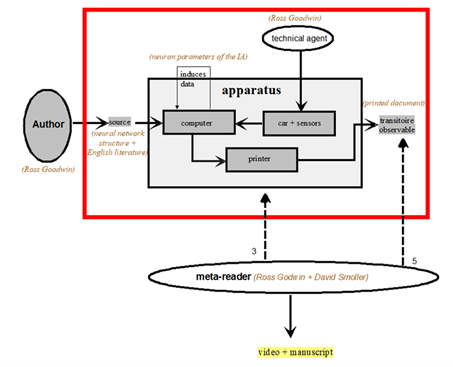
1.7 The écrit-lecteur
The ”écrit-lecteur” seems to be the same concept as the hypertextual wreader and in English one uses the same term for both concepts, but it is very different.
1.7.1 Barbosa’s concept of écrit-lecteur
Pedro Barbosa (1995) conceives the concept of écrit-lecteur from the use of syntext, a text generator. Syntext is in fact a meta-generator, a software able to create any text generator using the algorithm of sentences with holes: a first generative algorithm Christopher Strachey invented in 1952 (Strachey, 1954). Syntext is an interpreter of two data files: one contains the set of molds of sentences and the lists of vocabulary (fig. 17b) to fill the holes of the molds, and the other file (fig. 17a) manages the display of the generated text.
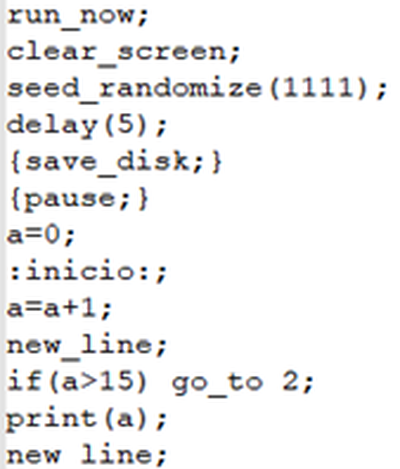

In the procedural visualization of Barbosa’s conception, the écrit-lecteur switches quickly between Author and Reader positions while they finalize the data files looking at the result on their computer. For Barbosa, at this time, the author is both an author and a reader.
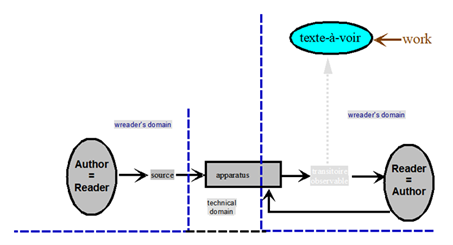
1.7.2 The écrit-lecteur as meta-reading
Barbosa’s point of view is not compatible with the procedural model hypothesis that an actor doesn’t communicate with themselves. In fact, the écrit-lecteur does not read as a Reader does in narrow reading. They only verify properties of the texte-à-voir they detect in the transitoire observable displayed on their own computer. It is not reading but verification. It is clearly an activity of meta-reading. While the actor finalizes the data files, they quickly switch between the meta-reading of watching the texte-à-voir knowing the texte-auteur, and the modification of the source in the Author position. Note that at this moment in time, there is no Reader position at all.
This behavior is internal to the Author position in the whole dispositif including the Reader position. It participates in its sub-system. When finalized, the source is classically sent to an apparatus toward a Reader for narrow reading.
Barbosa is not the programmer of syntext, only of data the program uses for running. Syntext was programmed by Abílio Cavalheiro who takes on the technical agents position in both apparatuses.
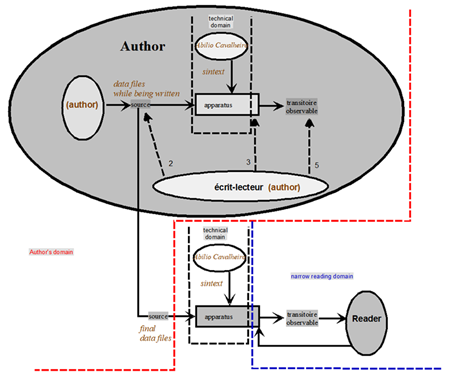
This écrit-lecteur always occurs in Author position in programmed e-lit; any author checks the result of their program by running it on their own computer in an écrit-lecteur behavior.
2. Semiotics treatments in the procedural model
2.1 Spaces of signs and signifying spaces
2.1.1 Spaces of sign vs signifying spaces
A space of sign for an actor is a space in which the actor can perceive signs. But an actor can also attribute meaning to a space they do not perceive. This space is called a signifying space for the actor.
The structural schema shows different potential spaces that are signs or signifying spaces, depending on the position the actor joins: the texte-à-voir, the texte-auteur and the Reading activity in narrow reading. Technical agent activity is also a space of signs in a performance. The internal transformation in the apparatus can also be a signifying space in all positions.
Author’s, Reader’s documents and second discourses are also signs.
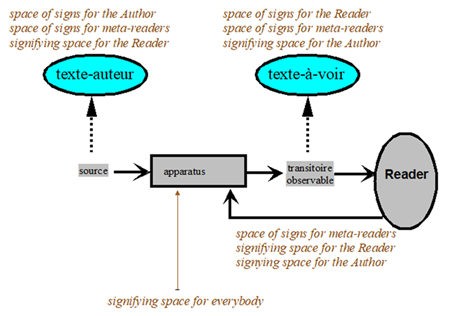
2.1.2 Impact of signifying spaces on interpretation
The transformation inside the apparatus is not a space of signs because no human being can show it, but it can be a signifying space. One can give meaning to this transformation because it is indexed in the texte-auteur (the program) and in the texte-à-voir. Several authors have made works precisely about this feature. I think of Sandy Baldwin’s Ping Poetics (2009) and of my adaptive generation (alire 7, 1994; Bootz, 2003). In Ping Poetics, Baldwin regards the apparatus as the time and space of his digital being. This meaning is indexed in both the texte-auteur and the texte-à-voir a meta-reader can perceive.
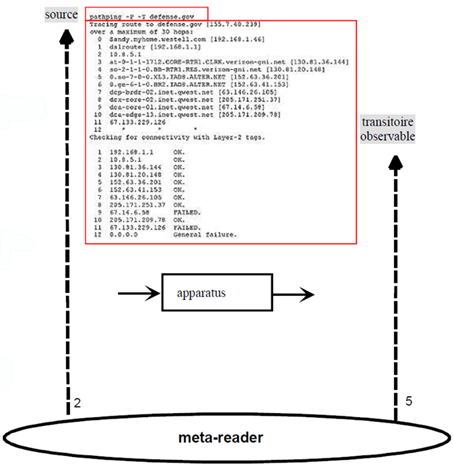
In adaptive generation, I regard the apparatus as the location of a conflict between the author’s intentionality delegated to the program and the intentionality the technical agents cause. This meaning is indexed only in the texte-auteur, the program. It cannot be perceived from the Reader position.
The behavior of the apparatus is a signifying space in the material metaphors Katherine Hayles introduces in her technotext theory. For instance, in Jean-Marie Dutey’s work Le mange-texte (1989), one material metaphor is due to obsolescence. A message error is displayed when one tries to run the program on current computers because it is an old DOS program. This error message comes from the OS, but one must consider that this message is inscribed in the transitoire observable of the work, even if this transitoire observable has no longer a causal relationship with the source. The causal link between the source and a transitoire observable this source logically describes is totally broken even though the transitoire observable exists. The work is obsolete for the Reader position, because they has access to nothing besides an error message, but not for a meta-reader. A meta-reader can rebuild from the texte-auteur the linguistic text that should logically appear in the texte-à-voir. This linguistic text uses the deictic “you” and it seems that the program talks to the Reader from the inside of the apparatus. The meta-reader can then interpret the impossibility to read the text in the narrowest reading imaginable; namely: as a material metaphor of death. In this material metaphor, the Reader position metaphorically plays the dead situation the text would express. The work cannot become obsolete for a meta-reader.

In general, as narrow reading activity is a space of signs for meta-reading, it is impossible not to read because the reader in the Reader position does not read the texte-à-voir from the outside of the work as they do in reading a book, they read inside the work for a meta-reader, even if nobody occupies the meta-reading position. Only the fact that meta-reading is a position in the dipositive makes this feature actual: it is impossible for you not to read a digital work you run. Just as it is not necessary for a book to be actually read for its text to make sense to a hypothetical reader, it is not necessary for the narrow reading activity to be actual for it to make sense to a hypothetical meta-reader.
In some cases, a reader can also interpret their own narrow reading activity. It is the double reading feature. For instance, Patrick Burgaud’s hypertextual work Florence Rey (2002) is very difficult to read: one often come back to the same nodes and it is difficult to find active areas. Florence Rey was in prison when Burgaud created this work and the preface explains that “This work deals with imprisonment […] Unlike the slightest ordering of multimedia information, the structure of this work is obscure, full of wandering, of backtracking, of returning to the same places over and over again. This is why the use of so-called interactivity is not at all explicit, rational or systematic. The mouse (the prisoner’s traditional rat companion in his dungeon) leads you to the end. But where, when and how to click? No clues are given, it’s up to you to figure it out.”1
These difficulties metaphorically make the reader playing the prisoner’s state of confinement of Florence Rey.
Doing a material metaphor, the reader can interpret their narrow reading as an experiment of the confinement.
2.2 Typology of signs
2.2.1 Distributed and not distributed signs
Author and Reader positions only access one space of signs. The text they perceive is built with signs belonging only to this one space. They are unary signs. As previously stated, additional signifying spaces can play a part in meaning.
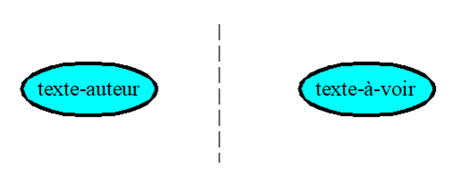
The situation is different for a meta-reader. They can access three spaces of signs. They can then perceive several texts that exist simultaneously and they can create rhetorical tropes between them. They are built with three different kinds of signs: unary signs that build texts in only one space, namely from the texte-à-voir or the texte-auteur, dual signs that build texts distributed across two different spaces, and ternary signs that build texts distributed on the three spaces.
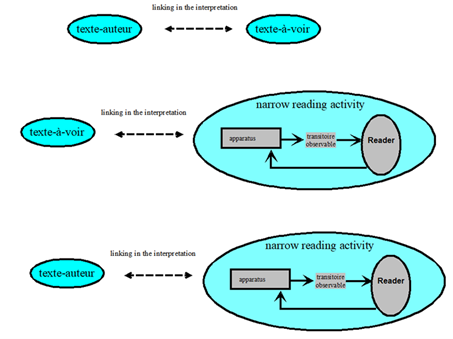
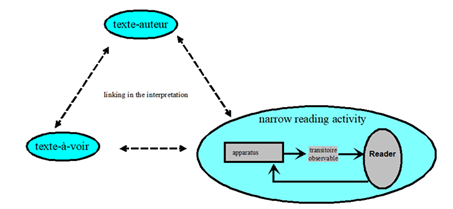
The model does not consider the transformation of signs from one space to another as the cybertext does with the traversal function between textons and scriptons, but it considers that these spaces are on the same plane, that they together contribute to a distributed text in meta-reading. It then makes possible to link these spaces in the interpretation of the distributed text.
2.3 Dual signs and the proximoron trope
Dual signs give a very rich rhetoric depending on the used meta-reading functionalities. Here are some examples in dual signs distributed on the texte-auteur and the texte-à-voir. These spaces are accessed using meta-reading modalities 2 and 5. The rhetoric changes when one considers a material metaphor using the modality 3 in addition. In the picture on the left, the first example on line one comes from my work passage (2010) and the second one, on the second line, showing a locomotive, is a programmed C obfuscated poetry by Marshall (1986).
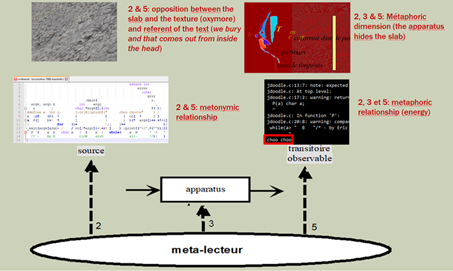
The relationship between the texte-auteur and the texte-à-voir in their whole very often creates a specific trope I call a proximoron that is made with opposite properties from each other. In this fact, the dual signs gathering these oppositions has an oxymoron dimension and the “pro” indicates that this oxymoron dimension only exists in programmed digital literature. The picture on the right shows the properties of the proximoron in Dutey’s Le mange-texte (1989).
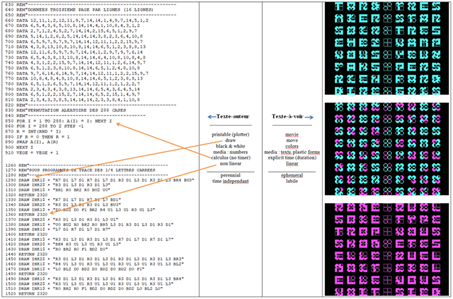
2.4 Program analysis in unary signs
2.4.1 Braids in the texte-auteur
Considering that unary signs in the texte-auteur participate to a text, means that one has to not only find computing signs in the program. Comments and names of variables are not computing signs, but we also have to give a non-computing meaning to instructions themselves.
There is yet no model to study computer code as a text, a set of signs that is not restricted to its computing functional nature. It is why I have created the braid model. I first designed it to create my own animated texts in 2003 and I have used it for program analyses since 2010 (Bootz, 2012). Recently I analyzed the whole source program of Tibor Papp’s work Orion (Bootz, 2022) with this model.
A braid is any part of program that makes sense in the Author or the meta-reader positions. It is a sign and, as any sign, it is relative to the person who perceives it, but it always has the same structure. The most important part of the braid is the head of braid (head braid in Figure 28) that contains the logic and goal of the braid. The head of braid expresses the algorithm saying for what purpose this braid exists, the why. Data media are also interesting to consider in a non-computing perspective. The effector expressed the algorithm describing how the goal of the braid is created, the how.
A braid generally produces some media on screen while running alone. It is often impossible to really and totally imagine what this media is, just by looking at the source code of the texte-auteur. This media is generally what the programmer wants their program to produce. It is the computing meaning of the braid.
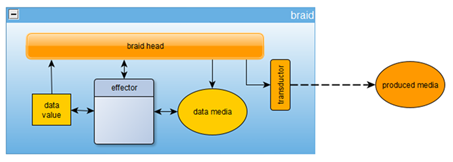
2.4.2 Ghost in the texte-à-voir
The media a braid produces is not necessary a part of the texte-à-voir while the whole program is running, because the transitoire observable results from interactions between several simultaneous braids. There can then occur some differences and rhetorical features between this media and the texte-à-voir. In this case, the media the braid produces while running is a ghost inside the texte-à-voir because it virtually really exists, it is really produced while running but it is never expressed, actualized, not in the code of the texte-auteur, nor in the texte-à-voir.
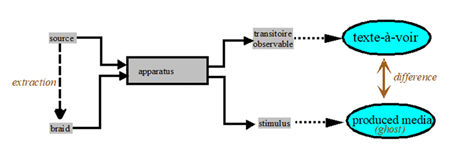
As an example of ghost, I have extracted one braid from my poem passage and run it alone. The poem the braid displays is different from the one displayed in the texte-à-voir. This is due to a coupling in the whole program between several braids during running. But the poem the extracted braid composes is not generative and really also composed while the braid runs inside the whole program. It is really created and not hidden, but it can never be seen. It is a ghost in the texte-à-voir.
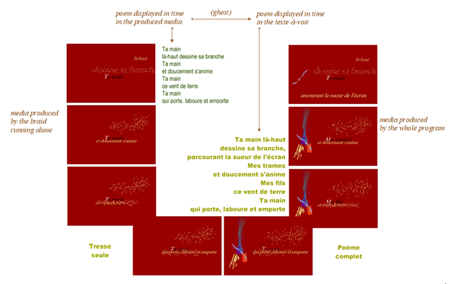
2.4.3 Unary signs inside braids
The braid itself is a non-computing unary sign of the texte-auteur, although it is written with computing language, as computing language itself is written with English language. But any part of its non-linear structure can also be a braid, mainly some data media and the head of braid. It is nothing else than the first articulation as it exists between monemes in linguistics: a sentence is a sign and it is composed with words that are also signs.
We can find some unary signs consisting of classical concrete poems in data media of bpNichol’s First Screening. These concrete poems are not displayed on screen and the braid that contains them do not create a final text in the texte-à-voir, only the beginning of an animated text in this example. So, using the vocabulary of the cybertext, the concrete poem is a texton but what it produces is not a scripton. The traversal function and the model of textons and scriptons are not enough to analyze the semiotic properties of digital texts.

Another interesting unary sign stands in the head of three different braids in Tibor Papp’s work Orion (2000). These braids build what we call a programmed form, which is to say, a fixed literary form in the sense that the sonnet is a fixed literary form, but this form is distributed in this braid and in the media the braid produces.
I call the programmed form Tibor has invented a “random under constraint”. It works like this: the program uses a sound poem as data media that is organized in a tabular structure. It randomly chooses a line of this structure it displays to the Reader. The sound texte-à-voir thus seems to be random in the Reader position.
The sound text in data media is built by applying a set of constraints on a minimum core set of sound texts. This set of constraints and core texts is not written in the program, the constraints must be deducted by a deep analysis of the data media structure. One then discovers that this data media is unique. No other possibility exists by applying the set of constraints on the core texts. Then, there is no random at all in the Author position.

Here the set of constraints and the core texts are ghosts inside the texte-auteur, not inside the texte-à-voir.
The program does not make the sound data media legible but works as a mediation between a text built with classic methods of constraints and the texte-à-voir.

3. To go further
3.1 The ontology of programmed digital literature
Regarding all these properties, how can we define or characterize a literary digital work? What is the ontology of the digital work?
The procedural model shows that the text is multiple and very difficult to grasp. It is not the same for everybody, it depends on the individual’s profondeur de dispositif and it changes depending on the position of the individual as Author, Reader in narrow reading or meta-reader. It is distributed on several spaces, built with several parts using unary, dual and ternary signs that can enter in rhetorical relationships to one another. It can contain ghosts in different levels that can only be detected by destructuring. It seems impossible in fact to define a literary digital work as a text.
Can we define it by a materiality as cybertext and technotext try to do?
The procedural model shows that this materiality is distributed on several parts of the dispositif. Worse, this dispositif is subject to lability and the transitoire observable is then unpredictable and different in the transition from one technical context to another. Some part of this materiality disappears with obsolescence. This materiality is then infinite, not perennial and not stable enough to make possible defining the work by its materiality.
We must turn to an ontology that does not focus on the materiality nor on the textuality. Spinozist ontology is a good candidate. For Spinoza the individual exists in two dimensions that are in relationship: the materiality and the essence. The materiality is infinite and mortal. These characteristics account to the dispositif. Spinoza argues that the essence is eternal and constitutes a power to act. The individual acts through their materiality. It is true that the materiality of the work: source, apparatus, transitoire observable, documents, act on all positions inside the dispositif. We can certainly not define but characterize a digital work, and any work in general, by a “power to act”. What can this power be?
My hypothesis is that a work acts on somebody as soon as this person considers that some part of the physical world is the materiality or a part of the material of a work. The work becomes literary work as soon as any text built on materiality is understood as a text or a part of a text. Said more simply, a work is a work or a literary work because some people consider it to be a work or a literary work. A digital literature piece is a digital literature piece because some people consider it is. It is ontological. It’s due to the fact that, in fact, only human beings act on other human beings through material and textual dimensions. The power to act of the work is a summary of human powers to act.
In this sense, materiality and text do not define a work, they are dimensions of a work. As a power to act, the work does not have to be the same for everybody, it is not mandatory that there is a cultural consensus on it: debates and controversies contribute to its action inside the world, they manifest its power to participate and then its existence as a work.
3.2 The reading machines
It is clear that narrow reading is unable to give access to all the textual richness of a digital literary work. Unfortunately, it often is the unique position in which a reader lies because the culture always is based on the front-end dispositif in which digital literature is understood as a unique screen-production, such as a “programmed literary cinema”. But it is not. The challenge then is to make legible for a reader in a Reader position the richness that only a meta-reader can access. Making legible the code itself is not the best solution and sometimes it is not the solution at all, at least to discover mentioned ghosts in the texte-à-voir.
Considering the work as a Spinozist individual opens another possibility. Applying this ontology, all non-human components of the dispositif participate in the materiality of the work, not only the source and the transitoire observable. Not all these components have the same status: the main dispositif is fundamental but documents also are parts of the infinite materiality of the work, at the border between extensive parts and materiality outside of them: they are parergonic components of the work, which means that these components belong to the parergon, a concept introduced by Kant and clarified by Derrida, who points out that it designates that which is “neither simply interior, nor simply exterior”. the term parergonic refers to this blur status to designate that which is at the frontier of the materiality of the work, which would correspond, in the Spinozist conception, to an extensive part having only a very weak relationship with the essence of the individual. (Bootz, 2015). As a comparison, the colossus of Rhodes no longer exists as a physical sculpture, but it continues to act on us through books and films. These books and films are its current materiality, they constitute a parergonic materiality of the work.
This Spinozist idea of the infinity of the individual materiality makes possible to add components to the materiality of the initial dispositif. I call reading machine (Bootz, 2022 b) this component conceived to express the richness discovered in meta-reading in a product accessible in narrow reading. This reading machine does not replace the narrow reading of the texte-à-voir but adds a new production in narrow reading consisting in interfaces and documents resulting from meta-reading. This reading machine is a second discourse in the procedural model, reinjected to the Reader position.
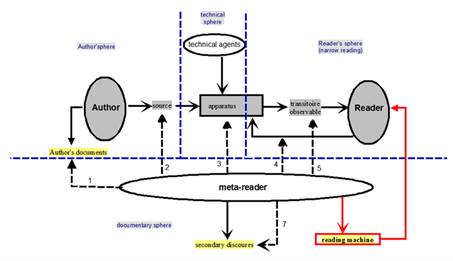
3.3 Preservation issues
The hypothesis that the work is mainly a power to act has an important consequence when it comes to a primary activity of literary scholarship; namely: preservation. Preservation does not have to maintain a certain state of materiality or of textual property. This goal participates in the literary work’s power to act but, at the same time, preservation has a tendency to fossilize this power and, if this goal is our only perspective, it forbids the literary work to act differently. It is in opposition to the mortal status of the work’s materiality. We have to assume this mortal status. It is inscribed in the work itself.
The real goal of preservation is to make possible for the work to act in the future, differently. As we don’t know how the work can act in the future, preservation must document, store, and record most of details about anything and not only about what is today regarded as the work. Even the most trivial and evident things must be stored because what is currently evident, trivial, and secondary, will no longer be evident, trivial, or secondary in the future.
Bibliography
Aarseth, Espen J. Cybertext: Perspectives on Ergodic Literature. Baltimore & London: Johns Hopkins University Press, 1997.
Baldwin, Sandy. « Ping Poetics ». electronic book review, electropoetics, 2009.
Balpe, Jean-Pierre. « Méta-auteur ». alire10/DOC(K)S 3.13/14/15/16, 1997, 9599.
Bolter, Jay David. Writing Space, The Computer, Hypertext and the History of Writing. Hillsdale New Jersey, Hove and London: Lawrence Erlbaum Associates, Publishers, 1991.
Barbosa, Pedro. « Syntext : un générateur de textes littéraires ». Littérature et Informatique, la littérature générée par ordinateur. Arras: Artois Presses Université, 1995 : 189202.
Bootz, Philippe. « Transformations graphiques normalisées ». Schéma et schématisation : revue de schématologie et de bibliologie, no 57 (trimestre 2002): 11121.
Bootz, Philippe. « Adaptive generators and temporal semiotics ». ELO conference, Morgantown, 2003.
Bootz, Philippe. Passage, alire 14, 2010
Bootz, Philippe. « The Nature of Signs in Programmed Digital Poetry ». 11th World Congress of Semiotics. Nanjing, 2012.
Bootz, Philippe. « Haut lieu de l’œuvre au lieu de l’œuvre ». E-formes3 : les frontières de l’œuvre numérique. Saint-Étienne: Saint-Etienne University Press, 2015: 10715.
Bootz, Philippe. « The Ephemerae of Digital Literature ». Neohelicon 48, no 1 (juin 2021): 722. https://doi.org/10.1007/s11059-021-00583-0.
Bootz, Philippe. « Les formes programmées dans Orion de Tibor Papp ». International colloquium “La littérature numérique hier et aujourd’hui : préserver l’ « art programmé », Bibliothèque nationale de France, 4 février 2022.
Bootz, Philippe. « Le concept de machine à lire dans une approche spinoziste de l’œuvre d’art numérique programmée ». International colloquium “La littérature numérique hier et aujourd’hui : préserver l’ « art programmé », Bibliothèque nationale de France, 4 février 2022 (b).
Bootz, Philippe, et Marcel Frémiot. passage 2009. Marseille: MIM, 2009.
Burgaud, Patrick, Florence Rey, 2002
Dutey, Jean-Marie. Le mange-texte. alire no 6 (1989).
Goodwin, Ross, Kenric McDowell, et Hélène Planquelle. 1 the Road. Art + machines 1. Paris: Jean Boîte éditions, 2018.
Hayles, N. Katherine. Writing Machines. Cambridge & London: MIT Press, 2002.
Klinkenberg, Jean-Marie. Précis de sémiotique générale. Bruxelles: De Boeck & Larcier, 1996.
Landow, George P. Hypertext: the convergence of contemporary critical theory and technology. Parallax. Baltimore: Johns Hopkins University Press, 1992.
Marshall, Eric, untitled poem, 3rd International Obfuscated C Code Contest, 1986. https://www.ioccc.org/1986/marshall/marshall.c
Nichol, Barrie Philip. First Screening. Toronto: Underwhich Editions, 1984.
Papp, Tibor. Orion. alire n° 11 (2000).
Rapkin, Lewis, Automatic on the road, 2018 (video).
Strachey, Christopher. « The “thinking” machine ». Encounter, no 13 (October 1954): 2531.
Vian, Boris. « Un robot-poète ne nous fait pas peur ». Arts, no 1016 (April 1953): 21926.
Winder, William. « Le Robot-poète : littérature et critique dans l’ère électronique ». In Littérature, informatique, lecture. De la lecture assistée par ordinateur à la lecture interactive, 187213. Limoges: PULIM, 1999.
Footnotes
-
« Cette œuvre traite de l’enfermement […] Contrairement à la moindre mise en ordre de l’information multimédia, la structure de cette œuvre est obscure, pleine d’errements, de retours en arrière, de passages par les mêmes endroits. C’est pourquoi l’utilisation de ce qu’il est convenu d’appeler l’interactivité en est aussi peu explicite, pas du tout rationnelle ni systématique. La souris (le rat compagnon traditionnel du prisonnier dans son cachot) vous mène vers la fin. Mais où, quand, comment cliquer ? Aucun indice ne vous sera donné, c’est à vous de vous débrouiller. » ↩
Cite this article
Bootz, Philippe. "The Praxis of the Procedural Model in Digital Literature, Part 2: Applications" Electronic Book Review, 5 January 2025, https://electronicbookreview.com/publications/the-praxis-of-the-procedural-model-in-digital-literature-part-2-applications/